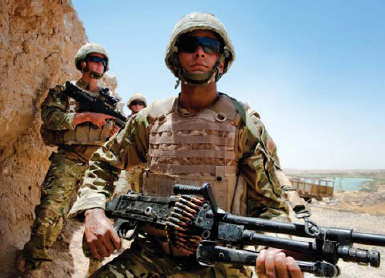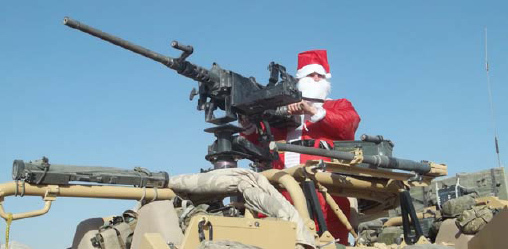I would recommend that a machine gun no longer be carried in an infantry section but that 7.62mm machine guns should be available on vehicles and supplied to static positions for use in their defence. Probably the advantage of a machine gun on a vehicle is that it is impossible to shoot accurately from a moving vehicle and so a machine gun gives you a better chance of hitting something. It also has a higher firing position to lay down suppressing fire but this is a two-edged sword in that it also makes a good target. In a defensive position, there is often little concern for weight of ammunition so the ability to lay down suppressing fire on the attacker becomes worthwhile.
The machine gun on patrol: When a light machine gun is taken out on patrol it has two folding legs under the barrel or fore-stock, which support the weapon at the best height for use when the gunner is laid behind it. These legs can be gripped as one handle for when the gun is fired from the hip in close combat. Wearing the sling across the opposite shoulder at the same time gives greater stability.
Historically two men have generally been assigned to the gun in an eight-man section – the gunner, to carry and fire it, and the commander, to carry extra ammunition and spot targets or defend the gunner. The commander, often a corporal, also carries a rifle and at least 1,000 belted rounds on a short patrol.

Parachute Regiment on patrol, Afghanistan 2010. A machine gun team take up a fire position. (Photo courtesy Tom Blakey)

A foot patrol of Royal Marines from Delta Company, 40 Commando passes near Kajaki, Afghanistan. (Si Ethell © UK Crown Copyright, 2010, MOD)
When a patrol is ‘surprised’ into action, by ambush or sudden confrontation, the members take cover separately and the two men on the gun often get parted which stops the commander getting the reserve ammunition to the gun and rendering it less useful. The British issued GPMG (General Purpose Machine Gun) weighs 27lb and the US M240 a little less, (both excellent 7.62mm medium machine guns) nevertheless, in the past I have thought it a good idea to put a strong man on the gun, let him carry no other stores and rest him regularly, but have him carry 500 or 1,000 rounds as well. Of course, this requires a fit and strong gunner but many gunners take pride in their ability to carry their gun.
The machine gun in a ‘fixed fire’ role: In a fixed position you don’t have to carry the gun so you can fit a heavier barrel – to stand the heat in case you have to fire at waves of attackers for long periods – and you can do something else which is quite clever: you can set up the gun on a special tripod which gives the facility to record the direction and elevation of the gun as it is test-fired at various likely targets in daylight. These might be ditches approaching the position or gaps in minefields or wherever the enemy might gather or assault in strength. These target settings are then kept safe and ready for when you are attacked during darkness, fog or smoke. Even if you are only guessing where the enemy are in their approach, or maybe you can hear but not see them, a good burst onto one of the recorded targets can really spoil the enemy’s evening.
The 12.7mm/.50in heavy machine gun is effective against buildings and can easily pass through two walls at 2,000m. Remember this if one is being fired at you. It is also effective against light armoured vehicles, particularly if supplied with armour piercing rounds. In counter-insurgency warfare you will not come across much enemy armour but if you have the vehicles try to keep a heavy machine gun handy for knocking down walls and buildings sheltering insurgents. I once carried the barrel of a 12.7mm (.50cal) Browning over some mountains for four days and, trust me, you do not want to carry one as infantry. Of course insurgents in Afghanistan often have Russian 12.7mm guns so take this into account with your armour and defences.
History: How did it develop to be the way it is?
Before the invention of the machine gun, infantry fired individual shots at each other at a rate of three rounds per minute per man if they had muzzle-loaders and slightly faster if they had an early breech loader. By the time of the American Civil War the all-metal cartridge, required both for a breech-loading rifle and for a machine gun, had just been invented but was not widely available. Prior to this a paper cartridge was bitten open, the bullet at the top kept in the mouth as the powder was poured down the barrel. Then the bullet was spat down the barrel followed by the paper cartridge as padding.
During the American Civil War the first machine gun appeared, having been invented by a Mr Gatling in 1861. This was hand cranked and fed by a long vertical magazine above several rotating barrels. Despite the disadvantages of generating a huge cloud of black powder smoke, and being a target for artillery they could not reach, the advantage of a weapon able to fire a couple of hundred rounds a minute against three rounds can easily be imagined. It made the gun equal in firepower to a company of men. Gatling guns were soon used to win empires all over the world.
A few years later the first self-powered machine gun with a single barrel was developed by Mr Maxim and this was quickly copied by Mr Vickers and others. By 1900 all machine guns were single barrel as this was lighter and cheaper to manufacture. By the outbreak of World War I in 1914 the machine gun had become the biggest killer of infantry in the open. Before World War II Mr Browning had devised the machine gun which bears his name and which is still in use today pretty much unchanged in .30in and .50in (12.7mm) forms.
Operation: How does it work?
There are three issues to be resolved in designing a machine gun: Automating Action (How do you make the gun complete the load, fire, extract cycle), Ammunition Feed (How do you bring the ammunition to the breech area) and Cooling (How do you stop the barrel melting – yes, the barrel really does get that hot). I have seen barrels glowing cherry red in the night when fending off a sustained attack. At times like this a gunner may be less concerned with avoiding melting the lining of his barrel and more concerned with health and safety. His own health and safety that is.
Types of automating action: There are three main types of automation used to power the firing cycle of a modern machine gun. These are gas, recoil and electric.
Many lighter types of machine gun – such as the 7.62mm – use what is called the ‘Gas System’ similar to that which operates assault rifles. In principle this involves a gas port near the muzzle of the barrel, which bleeds off a certain amount of gas from the firing of each round after the bullet has passed on its way to the muzzle. This gas is then channelled to push back a piston, against a spring, which pushes back the ‘working parts’ to extract the empty cartridge case and eject it. The spring then forces the working parts forward to pick up a new round and feed it into the breech. The gas system is fast and efficient but the working parts do get dirty quickly from the propellant. Black, hard ‘carbon’ forms on many of the working parts, particularly the piston. This must be cleaned off regularly or the gun will jam. The gas power, which is available to drive the cycle, can be adjusted by the user so as to raise the rate of fire or compensate for a dirty gun running slow or sticking.

Santa behind a Browning .50cal in Afghanistan, 2010. Spare barrel to right. (Photo courtesy Tom Blakey)